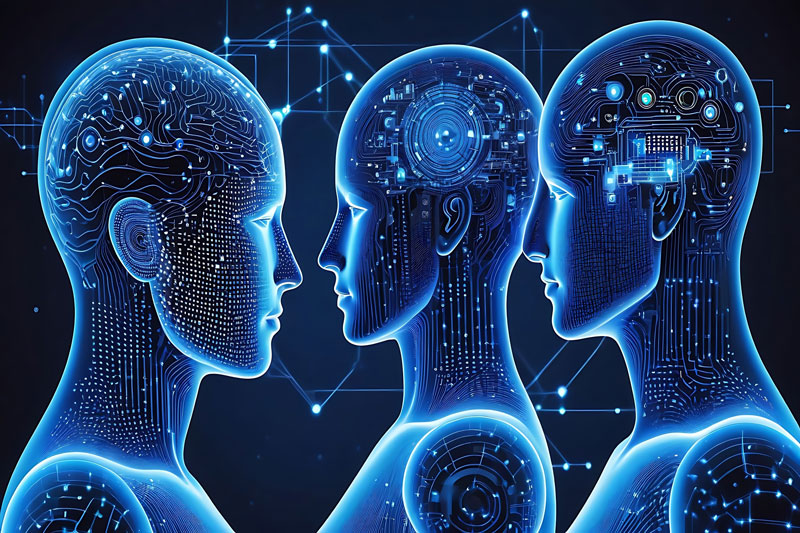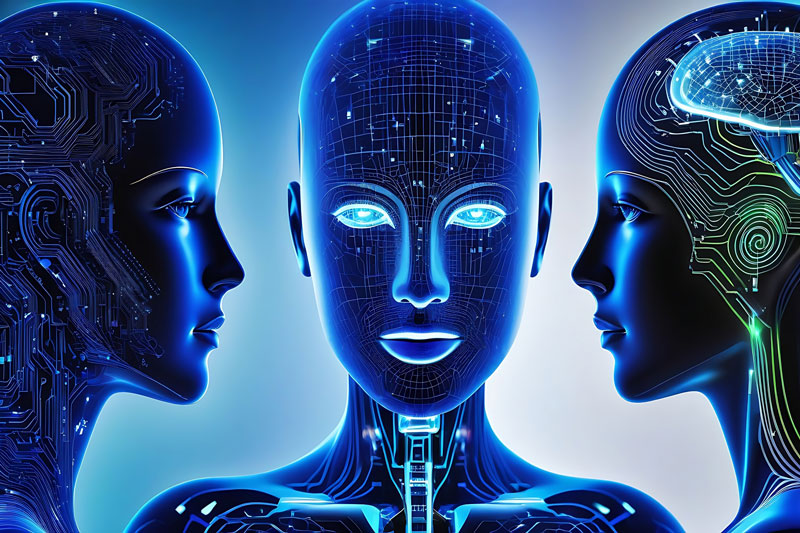In the realm of data science, three pillars stand prominently: Artificial Intelligence (AI), Machine Learning (ML), and Statistics. Each domain holds a distinct place in shaping our understanding of data and its applications. Understanding their individual roles and their intersections forms the foundation for harnessing the power of data-driven insights in our modern world.
Artificial Intelligence (AI): Often depicted in science fiction, AI represents the quest to imbue machines with intelligence comparable to human cognition. It encompasses a broad spectrum of techniques and technologies that enable systems to mimic human-like decision-making, problem-solving, and learning.
Machine Learning (ML): Nestled within the domain of AI, ML focuses on algorithms and models that allow computers to learn from data, improving their performance over time without being explicitly programmed. It empowers systems to recognize patterns, make predictions, and derive insights from vast datasets.
Statistics: The bedrock of data science, statistics provides the principles and methodologies for collecting, analyzing, interpreting, and presenting data. It offers a systematic approach to inferential reasoning, drawing conclusions and making predictions based on observed data and their inherent uncertainties.
This introduction sets the stage for an exploration of the distinct yet interconnected realms of AI, ML, and Statistics. By uncovering their individual strengths, their collaborative potential, and their application in various fields, we unravel the intricate tapestry of modern data science, paving the way for innovative advancements and transformative insights.
Best Books to Learn AI | Books for studying Artificial Intelligence
Top 20 Jobs that are Being Replaced by AI Right Now
Machine Learning Regression Algorithms & Models With Example
you may be interested in the above articles in irabrod.
What is Artificial Intelligence ?
Artificial Intelligence (AI) refers to the simulation of human intelligence processes by machines, particularly computer systems. It involves the development of algorithms and systems that can perform tasks that typically require human intelligence. AI aims to create machines that can think, learn, reason, perceive, and solve problems in ways similar to humans.
AI encompasses a wide range of techniques, approaches, and applications, including but not limited to:
1. Machine Learning (ML): ML is a subset of AI that focuses on enabling machines to learn from data without explicit programming. It includes algorithms that allow systems to improve their performance on a task as they are exposed to more data.
2. Natural Language Processing (NLP): NLP involves enabling machines to understand, interpret, and generate human language. It encompasses tasks such as language translation, sentiment analysis, and speech recognition.
3. Computer Vision: Computer vision aims to give machines the ability to interpret and understand visual information from the real world. This includes object recognition, image classification, and video analysis.
4. Robotics: AI is extensively used in robotics to enable machines to perform tasks autonomously, navigate in complex environments, and interact with humans.
5. Expert Systems: These are AI systems designed to mimic and emulate the decision-making abilities of a human expert in a particular field, often used for diagnostic purposes or providing recommendations.
AI is a rapidly evolving field with continuous advancements in algorithms, data processing capabilities, and computing power. Its applications span across various industries, including healthcare, finance, transportation, entertainment, and more, revolutionizing the way tasks are performed, solutions are generated, and decisions are made.
What is Machine Learning ?
Machine Learning (ML) is a subset of Artificial Intelligence (AI) that focuses on the development of algorithms and models that enable computers to learn and make predictions or decisions without being explicitly programmed. It involves creating systems that can automatically learn and improve from experience or data.
The core idea behind machine learning is to enable machines to recognize patterns, extract insights, and make predictions or decisions based on data. Instead of relying on explicit instructions or rules provided by programmers, ML algorithms learn from data, identifying patterns and relationships, and using this knowledge to perform specific tasks or make predictions on new, unseen data.
There are several types of machine learning approaches:
1. Supervised Learning: In supervised learning, algorithms are trained on labeled data, where the input data is paired with the corresponding correct output. The algorithm learns to map input to output by finding patterns in the labeled examples. Common tasks include classification (predicting categories) and regression (predicting continuous values).
2. Unsupervised Learning: Unsupervised learning involves training algorithms on unlabeled data to find patterns or structures within the data. Clustering, dimensionality reduction, and association rule learning are examples of unsupervised learning tasks.
3. Reinforcement Learning: Reinforcement learning involves training algorithms to make sequences of decisions in an environment to maximize a reward. The algorithm learns through trial and error, receiving feedback in the form of rewards or penalties.
Machine learning finds applications across various domains, including image and speech recognition, natural language processing, recommendation systems, predictive analytics, autonomous vehicles, healthcare, finance, and more. Its ability to learn from data and make predictions or decisions based on that learning has made it a fundamental and powerful tool in the field of artificial intelligence.
What is Statistics?
Statistics is a branch of mathematics that involves collecting, analyzing, interpreting, presenting, and organizing data. It provides methods and techniques for summarizing, describing, and making inferences or predictions from data. Statistics plays a crucial role in various fields by helping researchers, scientists, businesses, and policymakers make informed decisions and draw meaningful conclusions from data.
Key components of statistics include:
1. Descriptive Statistics: Descriptive statistics involve methods to summarize and describe features of a dataset. Measures such as mean, median, mode, variance, and standard deviation are used to describe the central tendency, dispersion, and shape of the data.
2. Inferential Statistics: Inferential statistics enables drawing conclusions or making predictions about a population based on a sample of data. It involves hypothesis testing, confidence intervals, and regression analysis, among other methods.
3. Probability Theory: Probability theory is foundational to statistics, dealing with the likelihood of events occurring in uncertain situations. It provides the mathematical framework for understanding randomness and uncertainty.
Statistics finds applications across numerous fields:
- Scientific Research: Statistics helps in experimental design, data collection, and analysis in various scientific disciplines such as biology, psychology, medicine, and more.
- Business and Economics: It aids in market research, forecasting, risk assessment, and making data-driven decisions in business operations and financial analysis.
- Social Sciences: Statistics is used to analyze survey data, conduct opinion polls, and study patterns in social sciences like sociology, political science, and economics.
- Quality Control and Manufacturing: It is applied to monitor and improve processes, ensure product quality, and make decisions based on statistical analysis in manufacturing and quality control.
Overall, statistics provides the tools and techniques to extract valuable insights, make evidence-based decisions, and draw reliable conclusions from data, contributing significantly to scientific discoveries, business strategies, and informed policymaking.
AI vs ML
Artificial Intelligence (AI) and Machine Learning (ML) are closely related fields within the broader domain of computer science, yet they have distinct characteristics and applications.
Artificial Intelligence (AI):
AI is a broad field of computer science that aims to create machines or systems capable of simulating human intelligence, exhibiting traits such as reasoning, learning, problem-solving, perception, and decision-making. AI encompasses a wide range of techniques, methodologies, and applications, including machine learning.
- Scope: AI covers a broad spectrum of capabilities, extending beyond learning from data to include various approaches like rule-based systems, expert systems, natural language processing, computer vision, and more.
- Objective: The goal of AI is to create systems that can perform tasks requiring human-like intelligence across diverse domains, from reasoning and problem-solving to understanding language and making decisions.
- Applications: AI finds applications in diverse fields such as robotics, healthcare, gaming, natural language processing, autonomous vehicles, recommendation systems, and more.
Machine Learning (ML):
ML is a subset of AI that focuses on enabling machines to learn from data and improve their performance on specific tasks over time without explicit programming. ML algorithms allow systems to learn patterns and make predictions or decisions based on data.
- Approach: ML algorithms learn from examples, iteratively improving their performance by recognizing patterns in the data.
- Learning Paradigms: ML can be categorized into supervised learning (using labeled data), unsupervised learning (finding patterns in unlabeled data), reinforcement learning (learning from interaction with an environment), and semi-supervised/active learning.
- Applications: ML is used in various applications such as image and speech recognition, recommendation systems, predictive analytics, fraud detection, autonomous vehicles, and more.
Relationship between AI and ML:
AI is a broader field that encompasses ML as one of its crucial components. ML provides the tools and techniques that enable machines to learn and improve their performance, contributing significantly to the realization of AI’s objectives. In essence, ML is a means to achieve AI by enabling machines to learn and exhibit intelligent behavior based on data.
AI vs Statistics
AI and Statistics are two distinct but interrelated fields that play significant roles in data analysis, modeling, and decision-making.
Artificial Intelligence (AI):
AI focuses on creating machines or systems that can simulate human intelligence, exhibiting traits such as learning, reasoning, problem-solving, perception, and decision-making. While AI encompasses various approaches beyond learning from data, including rule-based systems, natural language processing, robotics, and expert systems, it often heavily relies on statistical techniques, particularly in machine learning.
- Scope: AI encompasses a broad spectrum of capabilities, aiming to create systems that perform tasks requiring human-like intelligence across diverse domains.
- Objective: The goal of AI is to create intelligent systems that can perceive their environment, learn from experience, and make decisions or take actions to achieve specific goals.
- Applications: AI finds applications in areas such as robotics, healthcare, autonomous vehicles, gaming, natural language processing, recommendation systems, and more.
Statistics:
Statistics is a branch of mathematics focused on collecting, analyzing, interpreting, and presenting data. It provides methods and tools to summarize and draw inferences from data, often using probabilistic models and techniques.
- Scope: Statistics involves techniques for collecting, organizing, summarizing, analyzing, and interpreting data. It includes areas like descriptive statistics, inferential statistics, probability theory, hypothesis testing, and regression analysis.
- Objective: The goal of statistics is to describe and make inferences or predictions from data, drawing reliable conclusions and making evidence-based decisions.
- Applications: Statistics is used across various fields such as scientific research, business analytics, social sciences, quality control, finance, and more.
Relationship between AI and Statistics:
AI, particularly machine learning, relies heavily on statistical techniques and methodologies. Statistical concepts such as probability theory, regression analysis, hypothesis testing, and experimental design form the backbone of many machine learning algorithms. Statistics provides the theoretical foundation, methodologies, and tools that are crucial for analyzing data, training models, evaluating performance, and making predictions in AI systems.
In essence, while AI aims to create intelligent systems, Statistics provides the fundamental theories and techniques essential for analyzing data and enabling machines to learn and make decisions based on that data. AI and Statistics complement each other in advancing the field of data-driven intelligence and decision-making.
ML vs Statistics
Machine Learning (ML) and Statistics are interconnected fields that share common methodologies and objectives in dealing with data analysis, modeling, and inference. However, they differ in their approaches and emphases.
Machine Learning (ML):
- Approach: ML focuses on developing algorithms and computational models that enable systems to learn and improve their performance automatically from data.Learning from Data: ML algorithms learn patterns, relationships, and insights from datasets. The emphasis is on prediction and pattern recognition rather than on understanding the underlying relationships between variables.
- Applications: ML finds applications in diverse fields such as image and speech recognition, natural language processing, recommendation systems, predictive analytics, autonomous vehicles, and more.
- Techniques: ML includes various learning paradigms like supervised learning (with labeled data), unsupervised learning (without labeled data), reinforcement learning (learning from interaction), and semi-supervised/active learning.
Statistics:
- Approach: Statistics involves the collection, analysis, interpretation, and presentation of data. It aims to draw conclusions, make predictions, or infer relationships between variables based on data.
- Inference and Understanding: Statistics emphasizes understanding the relationships between variables, identifying causal relationships, and making generalizations about populations based on sample data.
- Applications: Statistics is widely used in scientific research, social sciences, business analytics, quality control, finance, and various other domains where data analysis and inference are crucial.
- Techniques: Statistics includes various methodologies such as hypothesis testing, probability theory, regression analysis, experimental design, and sampling techniques.
Relationship between ML and Statistics:
- Overlap: ML heavily relies on statistical principles and techniques for model building, validation, and evaluation. Many ML algorithms are based on statistical concepts such as probability distributions, hypothesis testing, and regression analysis.
- Complementary Roles: ML focuses more on predictive accuracy and complex pattern recognition, while Statistics emphasizes understanding relationships and making inferences about populations based on data.
In summary, while both ML and Statistics deal with data analysis and inference, ML often focuses on predictive modeling and pattern recognition using computational algorithms, while Statistics emphasizes understanding relationships between variables, making inferences, and drawing conclusions based on data. They complement each other, with Statistics providing the theoretical foundation, methodologies, and tools that are essential for analyzing data and enabling machines to learn and make decisions based on that data in ML applications.
Conclusion
In conclusion, the realms of Artificial Intelligence (AI), Machine Learning (ML), and Statistics represent integral facets of data-driven decision-making and computational intelligence, each contributing distinct yet interwoven elements to the field of data science.
Artificial Intelligence (AI): Embracing the broader quest to replicate human-like intelligence in machines, AI encompasses diverse approaches beyond data-driven learning. It aspires to create systems capable of reasoning, learning, perceiving, and making decisions across multifaceted domains.
Machine Learning (ML): Nestled within AI, ML focuses on algorithms and models that allow systems to learn and improve their performance from data, autonomously recognizing patterns and making predictions or decisions without explicit programming.
Statistics: A foundational pillar, Statistics provides the methodologies and tools for collecting, analyzing, interpreting, and drawing reliable conclusions from data. It emphasizes understanding relationships, making inferences, and quantifying uncertainty.
Interconnected Dynamics: AI draws from both ML, particularly its data-driven learning aspects, and Statistics, incorporating statistical methodologies in algorithms and models. ML, in turn, leverages statistical concepts to enable machines to learn, predict, and recognize patterns. Statistics provides the theoretical underpinnings and inference techniques essential for drawing meaningful insights from data.
Complementary Contributions: While AI aims for human-like intelligence, ML focuses on data-driven learning for predictions and pattern recognition, and Statistics emphasizes understanding relationships and making inferences. Together, they form a symbiotic ecosystem, with AI steering towards broader intelligence, ML mastering predictive analytics, and Statistics grounding insights in robust methodologies.
In essence, the triad of AI, ML, and Statistics converges to shape the landscape of modern data science, propelling innovations, fostering informed decision-making, and pushing the boundaries of intelligent systems by amalgamating computational prowess, data-driven learning, and statistical inference.








